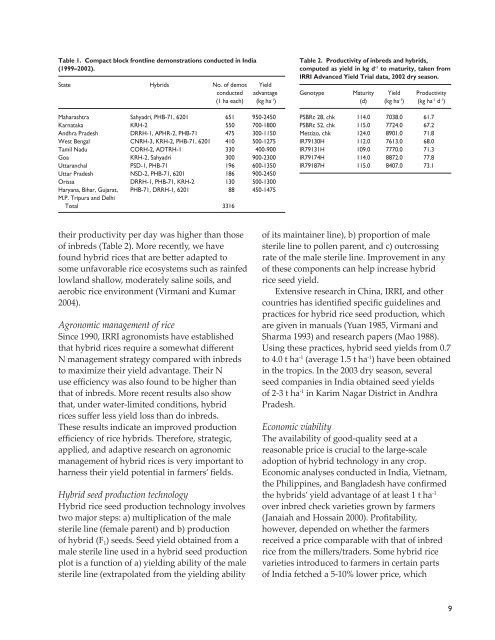Policy Support Needs of Hybrid Rice Technology in Asia - IRRI books
Policy Support Needs of Hybrid Rice Technology in Asia - IRRI books
Policy Support Needs of Hybrid Rice Technology in Asia - IRRI books
You also want an ePaper? Increase the reach of your titles
YUMPU automatically turns print PDFs into web optimized ePapers that Google loves.
Table 1. Compact block frontl<strong>in</strong>e demonstrations conducted <strong>in</strong> India<br />
(1999–2002).<br />
State <strong>Hybrid</strong>s No. <strong>of</strong> demos Yield<br />
conducted advantage<br />
(1 ha each) (kg ha -1 )<br />
Maharashtra Sahyadri, PHB-71, 6201 651 950-2450<br />
Karnataka KRH-2 550 700-1800<br />
Andhra Pradesh DRRH-1, APHR-2, PHB-71 475 300-1150<br />
West Bengal CNRH-3, KRH-2, PHB-71, 6201 410 500-1275<br />
Tamil Nadu CORH-2, ADTRH- 0 400-900<br />
Goa KRH-2, Sahyadri 00 900-2300<br />
Uttaranchal PSD-1, PHB-7 96 600-1350<br />
Uttar Pradesh NSD-2, PHB-71, 620 86 900-2450<br />
Orissa DRRH-1, PHB-71, KRH-2 130 500-1300<br />
Haryana, Bihar, Gujarat, PHB-71, DRRH-1, 6201 88 450-1475<br />
M.P. Tripura and Delhi<br />
Total<br />
6<br />
Table 2. Productivity <strong>of</strong> <strong>in</strong>breds and hybrids,<br />
computed as yield <strong>in</strong> kg d -1 to maturity, taken from<br />
<strong>IRRI</strong> Advanced Yield Trial data, 2002 dry season.<br />
Genotype Maturity Yield Productivity<br />
(d) (kg ha -1 ) (kg ha -1 d -1 )<br />
PSBRc 28, chk 114.0 7038.0 61.7<br />
PSBRc 52, chk 115.0 7724.0 67.2<br />
Mestizo, chk 124.0 8901.0 71.8<br />
IR79130H 112.0 7613.0 68.0<br />
IR79131H 109.0 7770.0 71.3<br />
IR79174H 114.0 8872.0 77.8<br />
IR79187H 115.0 8407.0 73.1<br />
their productivity per day was higher than those<br />
<strong>of</strong> <strong>in</strong>breds (Table 2). More recently, we have<br />
found hybrid rices that are better adapted to<br />
some unfavorable rice ecosystems such as ra<strong>in</strong>fed<br />
lowland shallow, moderately sal<strong>in</strong>e soils, and<br />
aerobic rice environment (Virmani and Kumar<br />
2004).<br />
Agronomic management <strong>of</strong> rice<br />
S<strong>in</strong>ce 1990, <strong>IRRI</strong> agronomists have established<br />
that hybrid rices require a somewhat different<br />
N management strategy compared with <strong>in</strong>breds<br />
to maximize their yield advantage. Their N<br />
use efficiency was also found to be higher than<br />
that <strong>of</strong> <strong>in</strong>breds. More recent results also show<br />
that, under water-limited conditions, hybrid<br />
rices suffer less yield loss than do <strong>in</strong>breds.<br />
These results <strong>in</strong>dicate an improved production<br />
efficiency <strong>of</strong> rice hybrids. Therefore, strategic,<br />
applied, and adaptive research on agronomic<br />
management <strong>of</strong> hybrid rices is very important to<br />
harness their yield potential <strong>in</strong> farmers’ fields.<br />
<strong>Hybrid</strong> seed production technology<br />
<strong>Hybrid</strong> rice seed production technology <strong>in</strong>volves<br />
two major steps: a) multiplication <strong>of</strong> the male<br />
sterile l<strong>in</strong>e (female parent) and b) production<br />
<strong>of</strong> hybrid (F 1 ) seeds. Seed yield obta<strong>in</strong>ed from a<br />
male sterile l<strong>in</strong>e used <strong>in</strong> a hybrid seed production<br />
plot is a function <strong>of</strong> a) yield<strong>in</strong>g ability <strong>of</strong> the male<br />
sterile l<strong>in</strong>e (extrapolated from the yield<strong>in</strong>g ability<br />
<strong>of</strong> its ma<strong>in</strong>ta<strong>in</strong>er l<strong>in</strong>e), b) proportion <strong>of</strong> male<br />
sterile l<strong>in</strong>e to pollen parent, and c) outcross<strong>in</strong>g<br />
rate <strong>of</strong> the male sterile l<strong>in</strong>e. Improvement <strong>in</strong> any<br />
<strong>of</strong> these components can help <strong>in</strong>crease hybrid<br />
rice seed yield.<br />
Extensive research <strong>in</strong> Ch<strong>in</strong>a, <strong>IRRI</strong>, and other<br />
countries has identified specific guidel<strong>in</strong>es and<br />
practices for hybrid rice seed production, which<br />
are given <strong>in</strong> manuals (Yuan 1985, Virmani and<br />
Sharma 1993) and research papers (Mao 1988).<br />
Us<strong>in</strong>g these practices, hybrid seed yields from 0.7<br />
to 4.0 t ha -1 (average 1.5 t ha -1 ) have been obta<strong>in</strong>ed<br />
<strong>in</strong> the tropics. In the 2003 dry season, several<br />
seed companies <strong>in</strong> India obta<strong>in</strong>ed seed yields<br />
<strong>of</strong> 2-3 t ha -1 <strong>in</strong> Karim Nagar District <strong>in</strong> Andhra<br />
Pradesh.<br />
Economic viability<br />
The availability <strong>of</strong> good-quality seed at a<br />
reasonable price is crucial to the large-scale<br />
adoption <strong>of</strong> hybrid technology <strong>in</strong> any crop.<br />
Economic analyses conducted <strong>in</strong> India, Vietnam,<br />
the Philipp<strong>in</strong>es, and Bangladesh have confirmed<br />
the hybrids’ yield advantage <strong>of</strong> at least 1 t ha -1<br />
over <strong>in</strong>bred check varieties grown by farmers<br />
(Janaiah and Hossa<strong>in</strong> 2000). Pr<strong>of</strong>itability,<br />
however, depended on whether the farmers<br />
received a price comparable with that <strong>of</strong> <strong>in</strong>bred<br />
rice from the millers/traders. Some hybrid rice<br />
varieties <strong>in</strong>troduced to farmers <strong>in</strong> certa<strong>in</strong> parts<br />
<strong>of</strong> India fetched a 5-10% lower price, which

















